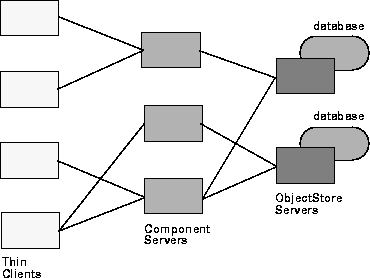Introduction
Taking Advantage of the Cache-Forward Architecture
ObjectStore is designed to maximize performance and ease of development for distributed, component-based applications by supporting
With many applications, using the component caches most effectively means allowing each end user to use many caches, as well as allowing many end users to use the same cache.
That way requests from different end users that require similar data sets can be routed to the same cache. This minimizes invalidation of other component caches, reducing network traffic due to callbacks and refetched data.
Moreover requests from the same end user that require different data sets can each be routed to different caches. Each request can be handled by a cache that is likely to contain the necessary data already. This means most data access can take place at in-memory speeds, with no database Server overhead.
This requires a multitier architecture in which thin client processes send requests to component servers, which service requests by using components in the form of shared libraries. These servers, in turn, are clients of ObjectStore database Servers, which maintain cache validity, propagate updates to persistent storage, and service any component requests for additional data.
Multitier Architecture for ObjectStore Applications

For web-based applications, thin clients run on the web server host, either as a CGI executable or as a shared library executing in the web server process space (for example as an NSAPI or ISAPI shared library).
The ObjectStore Component Server Framework provides a Component Server executable for which you can build thin clients and components. You can build thin clients with the Framework's thin client API, or with OLE DB or ADO. You can build components with the Framework's Server API together with the ObjectStore C++ API.
[previous] [next]
